

Nanomaterials could pose health risks, need more oversight, council says. Not enough is known about the health and environmental effects of nanomaterials and nanoproducts, says a new report released Thursday, and more must be done to regulate items that contain them.
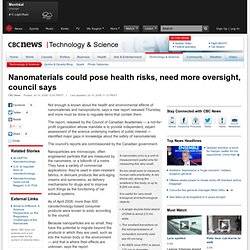
The report, released by the Council of Canadian Academies — a not-for-profit organization whose mandate is to provide independent, expert assessment of the science underlying matters of public interest — identified major gaps in knowledge about the safety of nanomaterials. The council's reports are commissioned by the Canadian government. A nanometre (nm) is a unit of measurement useful only for measuring the very small. It's too small even to measure human cells practically. A red blood cell, among the smallest in the body, is up to 8,000 nm wide. It is useful for very small biological and technological objects: A single double-helix strand of DNA is about 2.5 nm wide. Averting a Nano Tragedy. Although there is no proof of health risks to humans from nanoparticles, studies do show that materials at this scale behave in some worrying ways, for example, by slipping from the lungs into the bloodstream, and infiltrating other organs, possibly even the brain.
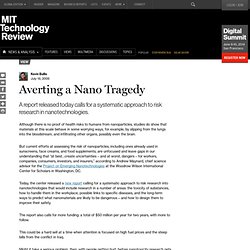
But current efforts at assessing the risk of nanoparticles, including ones already used in sunscreens, face creams, and food supplements, are unfocused and leave gaps in our understanding that “at best…create uncertainties – and at worst, dangers – for workers, companies, consumers, investors, and insurers,” according to Andrew Maynard, chief science advisor for the Project on Emerging Nanotechnologies at the Woodrow Wilson International Center for Scholars in Washington, DC. The report also calls for more funding: a total of $50 million per year for two years, with more to follow. "Nano" Safety Recall. The hospitalization of six Germans after they used a product called Magic Nano has renewed calls for better research into the toxicity of nanoparticles and possibly new laws or regulations governing their manufacture and use.
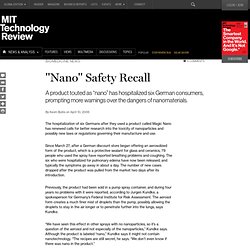
Nanocosmetics: Buyer Beware. The following article appears in the March/April 2007 issue of Technology Review.
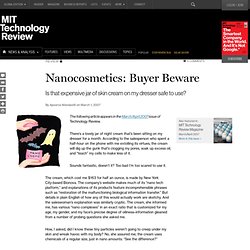
There’s a lovely jar of night cream that’s been sitting on my dresser for a month. According to the salesperson who spent a half-hour on the phone with me extolling its virtues, the cream will dig up the gunk that’s clogging my pores, soak up excess oil, and “teach” my cells to make less of it. Sounds fantastic, doesn’t it? Too bad I’m too scared to use it. The cream, which cost me $163 for half an ounce, is made by New York City-based Bionova. How, I asked, did I know these tiny particles weren’t going to creep under my skin and wreak havoc with my body? Not really. I still didn’t understand how the product could be called nanotech if it didn’t actually use nano-sized particles. Coalition Calls for Smart Definition of Nanotechnology. (Beyond Pesticides, November 29, 2010) A coalition of over 40 environmental organizations from 22 different countries are calling on the European Commission to ensure nanomaterials are adequately defined and regulated in the EU by rapidly adopting a “cautious and broad” definition.
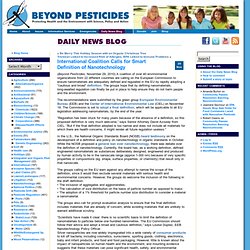
The groups hope that by defining nanomaterials, long-awaited regulation can finally be put in place to help ensure they do not harm people and the environment. The recommendations were submitted by the green group European Environmental Bureau (EEB) and the Center of International Environmental Law (CIEL) on November 19. Making Nanotech Safer. As thin as one nanometer in diameter and stronger than steel, carbon nanotubes have been called a “poster child for the ‘nanotechnology revolution.’ ” Environmental chemist Desirée Plata, PhD ‘09, wants to make sure that they don’t become a poster child for environmental destruction.

In 2007, Plata and colleagues at MIT, the Woods Hole Oceanographic Institution (WHOI), and the University of Michigan found that a common process used in manufacturing nanotubes releases more than a dozen harmful by-products, including chemicals that cause cancer and contribute to global warming. Three years later, the researchers showed how to tweak the process so that it’s more efficient and less toxic. She calls her approach “preventive science”: instead of waiting for carbon nanotubes to become ubiquitous and then scrambling to clean up the damage, she says, “we can use science to predict environmental problems and engineering to prevent them.”
New Nano Law? Nanotechnology materials have numerous new properties that make them potentially useful, but it is not yet clear how these materials might act in the body or the environment.
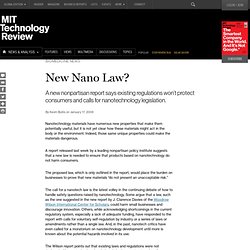
Indeed, those same unique properties could make the materials dangerous. A report released last week by a leading nonpartisan policy institute suggests that a new law is needed to ensure that products based on nanotechnology do not harm consumers. Can Nanotech Be Regulated? Recent toxicology studies have given some concern that nanomaterials could poise unique hazards.

Technology Review asked Richard Denison, senior scientist at Environmental Defense and a long-time observer of the U.S. environmental regulation system, how we should regulate nanotechnology. Technology Review: What is your reaction to the recent Woodrow Wilson Center report that called for new legislation to regulate nanotechnology? Richard Denison: It pinpoints quite nicely the fact that we have a system in place that was built to handle different types of materials than nanomaterials, and that it’s a stretch to argue that it could be easily adapted to fit the unique properties of nanomaterials. The solution side is tougher.